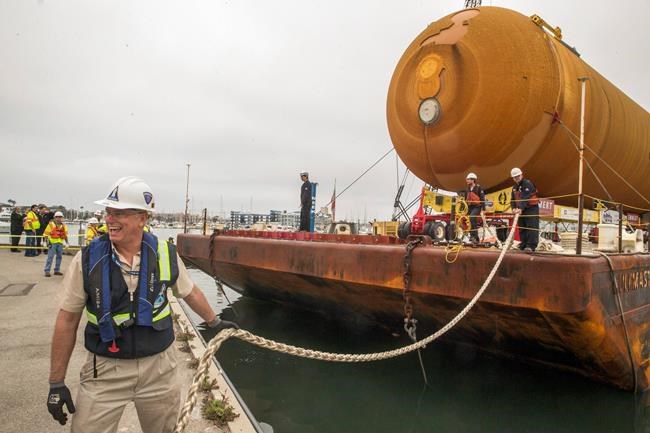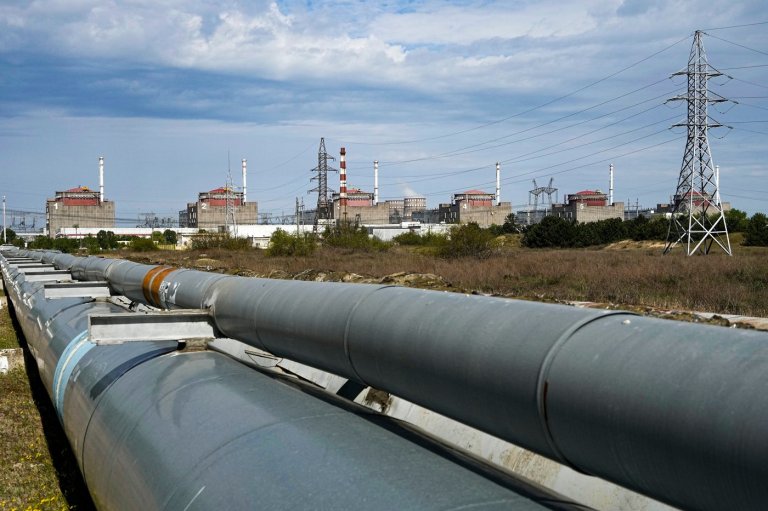
Space shuttle tank completes trek to Los Angeles museum
LOS ANGELES – A colossal space shuttle fuel tank completed its 19-hour trek through the streets of Los Angeles on Saturday to join the retired orbiter Endeavour on display at the California Science Center.
The 33-ton, 154-foot-long external propellant tank began moving a few minutes after midnight from coastal Marina del Rey, where it arrived by barge Wednesday. It reached the museum at Exposition Park just after 7 p.m. following a carefully-co-ordinated journey down 16 1/2 miles of streets.
The orange-brown, sausage-shaped tank — the last of its kind — travelled by truck at about 5 mph. It was escorted by police, a fire truck, and several city officials and astronauts while crews trimmed a few trees and unbolted stoplight poles so they wouldn’t hit the towering tank.
Freeway drivers got a shock as the tank rolled by on a bridge over Interstate 405, an artery west of downtown that was busy even on Saturday morning.
Along the route, people lined the sidewalks with their cellphones, trying to capture the perfect shot — and a selfie.
“When you look at the people who are out here, it’s little kids, it’s older folks, it’s white folks, it’s black folks, it’s Latino folks,” said Shelly Arsneault, 49, of Whittier. “It’s everybody. It’s cool. It’s LA.”
Children, a few wearing home-made space helmets, were enthralled.
Cindy Hernandez, 11, of Inglewood, said the tank was “amazing.”
“It will be a memory for me,” she said.
“It’s this next generation of explorers. These kids are going to remember today their whole lives. And they’re going to think about it when they choose their career paths. They’re going to study harder in school. And it’s going to make us happy,” astronaut Mike Fincke, who flew on the Endeavour’s final flight in 2011, told the Los Angeles Times.
“It really makes me feel that a lot of people appreciate what our space program is doing,” said Sandy Magnus, another astronaut. “Days like this I think are days that bring us all together.”
The tank will be displayed upright along with the shuttle and two solid-rocket boosters, as if ready for takeoff.
The trek drew smaller crowds than the journey of the 122-foot-long Endeavour. With a wingspan of 78 feet, the orbiter was similarly hauled 12 miles to the centre from Los Angeles International Airport. Extensive preparations for Endeavour’s trek included removing trees, street posts and other obstacles, but that journey still took about 17 hours longer than planned.
Although longer, the external tank is much narrower than the shuttle, with a diameter of 27.5 feet.
The tank was shipped to California by barge from a NASA facility in Louisiana. The tank travelled through the Panama Canal to the Pacific and arrived at Marina del Rey, a yacht harbour on the Los Angeles County coast where it was offloaded to await the weekend move.
The move Saturday began with a bit of fanfare. A New Orleans-style jazz band played “When the Saints Go Marching In,” and some people waved handkerchiefs to wish the tank bon voyage.
Known as ET-94, it was NASA’s last flight-qualified external tank, but it was never used before the shuttle program came to an end.
External tanks not only carried propellant for space shuttles’ main engines, they were the backbone of the launch system. An orbiter and two solid rocket boosters would be attached to the tank for the fiery ascent into space.
Inside ET-94 are two internal tanks for millions of pounds of liquid oxygen and liquid hydrogen as well as other equipment.
The tank’s surface is covered with a layer of foam to keep the propellants at the proper temperature, reduce the formation of ice and to provide protection from heat as it sped through the atmosphere.
External tanks used on shuttle missions would be destroyed, burning up as they fell back through the atmosphere after being discarded by the orbiter.
ET-94 was built for use by the shuttle Columbia, which disintegrated over Texas as it was returning from a mission. The investigation found that foam fell off that mission’s external tank during launch and punched a hole into a wing, allowing hot gases of the fiery re-entry inside the structure. Investigators used many pieces of foam from ET-94 in tests to come to the conclusion.
Join the Conversation!
Want to share your thoughts, add context, or connect with others in your community?
You must be logged in to post a comment.


















